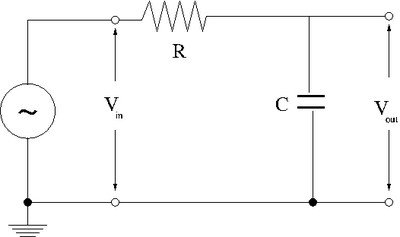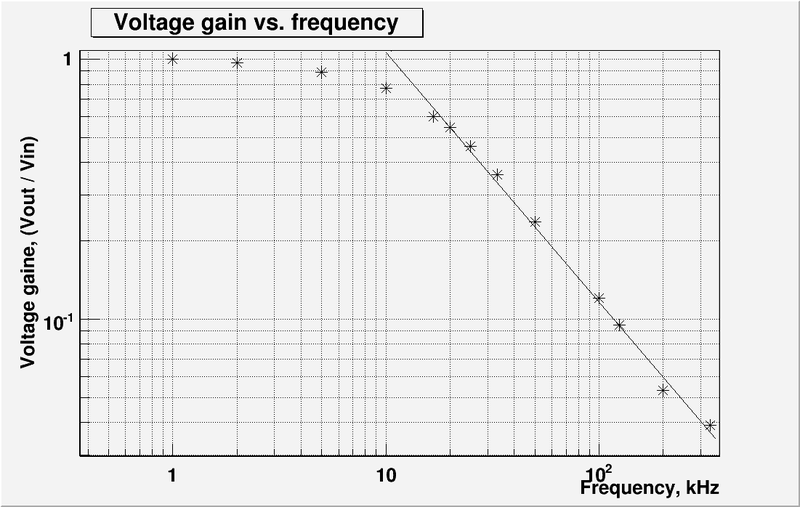Lab 3 RS
- RC Low-pass filter
1-50 kHz filter (20 pnts)
1. Design a low-pass RC filter with a break point between 1-50 kHz. The break point is the frequency at which the filter starts to attenuate the AC signal. For a Low pass filter, AC signals with a frequency above 1-50 kHz will start to be attenuated (not passed).
- To design low-pass RC filter I had:
2. Now construct the circuit using a non-polar capacitor.
3. Use a sinusoidal variable frequency oscillator to provide an input voltage to your filter.
4. Measure the input and output voltages for at least 8 different frequencies which span the frequency range from 1 Hz to 1 MHz.
| 0.1 | 5.0 | 5.0 | 1.0 | ||
| 1.0 | 4.2 | 4.2 | 1.0 | 15.0 | 0.094 |
| 2.0 | 3.2 | 3.1 | 0.97 | 15.0 | 0.188 |
| 5.0 | 1.8 | 1.6 | 0.89 | 15.0 | 0.471 |
| 10.0 | 1.14 | 0.88 | 0.77 | 10.0 | 0.628 |
| 16.7 | 0.90 | 0.54 | 0.60 | 10.0 | 1.049 |
| 20.0 | 0.88 | 0.48 | 0.54 | 8.0 | 1.005 |
| 25.0 | 0.82 | 0.38 | 0.46 | 7.0 | 1.099 |
| 33.3 | 0.78 | 0.28 | 0.36 | 6.0 | 1.255 |
| 50.0 | 0.76 | 0.18 | 0.24 | 4.5 | 1.413 |
| 100.0 | 0.75 | 0.09 | 0.12 | 2.0 | 1.256 |
| 125.0 | 0.74 | 0.07 | 0.095 | 1.8 | 1.413 |
| 200.0 | 0.75 | 0.04 | 0.053 | 0.8 | 1.005 |
| 333.3 | 0.76 | 0.03 | 0.039 | 0.25 | 0.523 |
| 200.0 | 0.76 | 0.03 | 0.039 | -0.25 | -0.785 |
| 1000.0 | 0.78 | 0.06 | 0.077 | -0.25 | -1.570 |
5. Graph the -vs-
phase shift (10 pnts)
- measure the phase shift between and as a function of frequency . Hint: you could use as an external trigger and measure the time until reaches a max on the scope .
See table above, columns #5 and #6.
Questions
- Compare the theoretical and experimentally measured break frequencies. (5 pnts)
Experimentally measured break frequency: 10 kHz
Theoretical break frequency: 12.1 kHz
- Calculate and expression for as a function of , , and . The Gain is defined as the ratio of to .(5 pnts)
We have:
So
And we are need the real part
- Sketch the phasor diagram for ,, , and . Put the current along the real voltage axis. (30 pnts)
- Compare the theoretical and experimental value for the phase shift . (5 pnts)
- what is the phase shift for a DC input and a very-high frequency input?(5 pnts)
- calculate and expression for the phase shift as a function of , , and graph -vs . (20 pnts)

